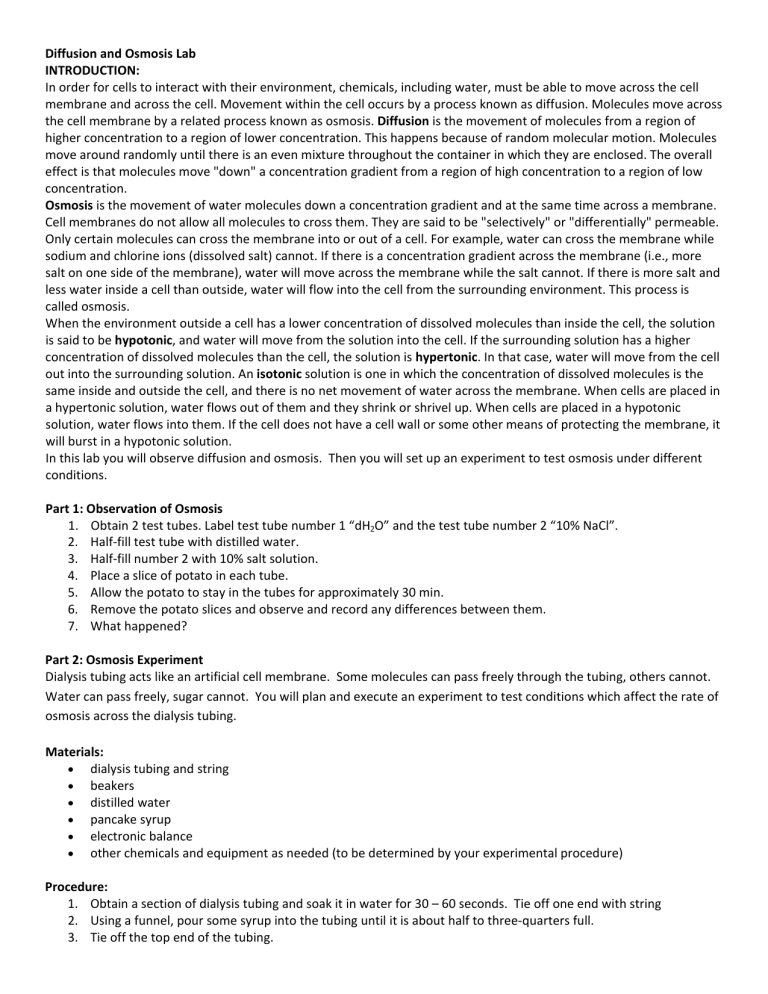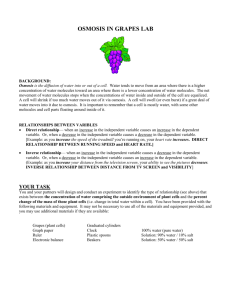Diffusion and Osmosis Lab INTRODUCTION
advertisement

Diffusion and Osmosis Lab INTRODUCTION: In order for cells to interact with their environment, chemicals, including water, must be able to move across the cell membrane and across the cell. Movement within the cell occurs by a process known as diffusion. Molecules move across the cell membrane by a related process known as osmosis. Diffusion is the movement of molecules from a region of higher concentration to a region of lower concentration. This happens because of random molecular motion. Molecules move around randomly until there is an even mixture throughout the container in which they are enclosed. The overall effect is that molecules move "down" a concentration gradient from a region of high concentration to a region of low concentration. Osmosis is the movement of water molecules down a concentration gradient and at the same time across a membrane. Cell membranes do not allow all molecules to cross them. They are said to be "selectively" or "differentially" permeable. Only certain molecules can cross the membrane into or out of a cell. For example, water can cross the membrane while sodium and chlorine ions (dissolved salt) cannot. If there is a concentration gradient across the membrane (i.e., more salt on one side of the membrane), water will move across the membrane while the salt cannot. If there is more salt and less water inside a cell than outside, water will flow into the cell from the surrounding environment. This process is called osmosis. When the environment outside a cell has a lower concentration of dissolved molecules than inside the cell, the solution is said to be hypotonic, and water will move from the solution into the cell. If the surrounding solution has a higher concentration of dissolved molecules than the cell, the solution is hypertonic. In that case, water will move from the cell out into the surrounding solution. An isotonic solution is one in which the concentration of dissolved molecules is the same inside and outside the cell, and there is no net movement of water across the membrane. When cells are placed in a hypertonic solution, water flows out of them and they shrink or shrivel up. When cells are placed in a hypotonic solution, water flows into them. If the cell does not have a cell wall or some other means of protecting the membrane, it will burst in a hypotonic solution. In this lab you will observe diffusion and osmosis. Then you will set up an experiment to test osmosis under different conditions. Part 1: Observation of Osmosis 1. Obtain 2 test tubes. Label test tube number 1 “dH2O” and the test tube number 2 “10% NaCl”. 2. Half‐fill test tube with distilled water. 3. Half‐fill number 2 with 10% salt solution. 4. Place a slice of potato in each tube. 5. Allow the potato to stay in the tubes for approximately 30 min. 6. Remove the potato slices and observe and record any differences between them. 7. What happened? Part 2: Osmosis Experiment Dialysis tubing acts like an artificial cell membrane. Some molecules can pass freely through the tubing, others cannot. Water can pass freely, sugar cannot. You will plan and execute an experiment to test conditions which affect the rate of osmosis across the dialysis tubing. Materials: • dialysis tubing and string • beakers • distilled water • pancake syrup • electronic balance • other chemicals and equipment as needed (to be determined by your experimental procedure) Procedure: 1. Obtain a section of dialysis tubing and soak it in water for 30 – 60 seconds. Tie off one end with string 2. Using a funnel, pour some syrup into the tubing until it is about half to three‐quarters full. 3. Tie off the top end of the tubing. 4. Place the tube with the syrup in a beaker with about 500 mL of water (the exact amount of water isn't important). 5. Remove the tubing, blot it on paper toweling, and measure the mass. This is the initial (time 0) mass. 6. Replace the tube into the water. Allow it to remain in the water for 5 minutes. 7. Remove the tube, blot, and measure the mass. 8. Repeat steps 6 and 7 five times, recording the time and mass each time. This is your control data. 9. Discuss with your lab group conditions which may affect the rate of osmosis. Calculations: 1. Graph your data 2. Calculate the slope of each of your graphs. a. Choose 2 data points which fall on the line. b. Subtract the first (earlier time) mass from the second mass c. Subtract the first time from the second time. d. Divide the difference in mass by the difference in the time. This is the rate of diffusion in grams per minute. 3. Compare the rates of the initial experiment with the variable you tested. Lab Report: 1. Title: A few words which give a sense of the lab. 2. Introduction defining diffusion, osmosis, isotonic solution, hypotonic solution, and hypertonic solution (do not copy my introduction!). 3. Procedure: Anyone reading this can reproduce the lab. 4. Data Section: 1. Report your observations of osmosis in potato strips. 2. Present your osmosis data in a data table. Use a straight‐edge for construction of the table. Include title, labels, and units. Include qualitative data. 3. Why did the observed changes occur? 5. Analysis Section: 1. Graph your osmosis data. Follow graphing instructions provided by your teacher. Graphs are to be hand‐drawn on graph paper. 2. Calculate the rates of osmosis for both your control and your experiment (see directions above). 3. Choose one factor or condition that may affect osmosis/diffusion. Describe the effect it would have on the process. 4. Explain the results of both parts of the experiment. Be sure to descriptive terminology (hypertonic, hypotonic, and isotonic). 6. Conclusion Section: 1. Explain your results. Why did the observed mass changes occur? What affects the rate of osmosis? 2. Meta‐cognitive Analysis: What contributed most to your learning in this lab? What was confusing or didn't work in this lab, and why? What would you change?






